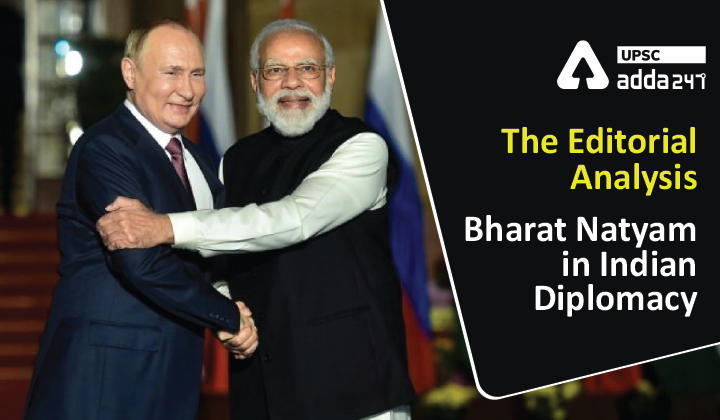Table of Contents
‘Bharat Natyam’ in Indian Diplomacy- Relevance for UPSC Exam
- GS Paper 2: International Relations- Effect of policies and politics of developed and developing countries on India’s interests.
‘Bharat Natyam’ in Indian Diplomacy in news
- Indian maneuvering in the ongoing Russia Ukraine war reminds us the turbulent times of 1990s when late Jyotindra Nath, then Foreign Secretary of India, managed to secure India interests.
Global Situation in 1990s and Indian Diplomacy
- Dissolution of USSR: On December 25, 1991, Soviet Union’s General Secretary Mikhail Gorbachev resigned, the following day, the USSR was formally dissolved.
- Indian Challenge: India had to set up new embassies to build new relationships with countries in Central Asia, the South Caucasus and Central Europe while maintaining its traditional ties with Moscow.
- India-Israel Relations: In January 1992, India and Israel established full diplomatic relations, announcing the opening of embassies and exchanging Ambassadors for the first time.
- This opened the door to a relationship that has blossomed into one of India’s most significant strategic partnerships in the last three decades.
- UNSC Meeting 1992: Prime Minister P.V. Narasimha Rao participated in the first-ever meeting of the United Nations Security Council at the summit level (India was a member in 1991-92).
- On the sidelines, India and USA decided that in the changing world, India and the U.S. needed to have frank exchanges on issues that had divided them during the Cold War;
- The issue identified was ‘nuclear proliferation and disarmament’, sowing the seeds of the dialogue that continued through ups and downs, leading to the path-breaking India-U.S. Civil Nuclear Cooperation Agreement in 2008.
- India-ASEAN Relations: ‘Look East’ policy began to take shape as India and ASEAN embarked on a sectoral-dialogue partnership.
- By the end of 1995, this had matured into a full-dialogue partnership and in 1996, India joined the security dialogue platform, the ASEAN Regional Forum.
- Since 2002, the relationship has strengthened further with the annual India-ASEAN summit.
- On China and Taiwan: In 1993, India China initiated the first of many confidence-building measures, notably the Agreement on the Maintenance of Peace and Tranquility Along the Line of Actual Control in the India-China Border Areas.
- It laid the foundation of the relationship for two decades.
- Simultaneously, India and Taiwan negotiated to open economic and cultural centres;
- Taiwan opened its office first in Mumbai in 1992 before shifting to Delhi while India established the India-Taipei Association office in 1995.
The Editorial Analysis- Russia’s NATO Problem
India’s stand on UNSC Votes on Russia-Ukraine War
- India’s Stand: The Indian government has chosen to ‘abstain’ in various UN voting on the Russia Ukraine conflict, based on an assessment of its core interests.
- What it means: A ‘for’ or ‘against’ vote is intended to convey a blunt message of ‘support’ or ‘opposition’.
- On the other hand, ‘abstention’ takes us into a grey zone because it is the middle path.
- It can either be seen as fence-sitting (which is a sign of helplessness) or create space for diplomatic maneuver (which is a successful outcome).
- Balancing Act: The West should feel satisfied that India ‘abstained’ because it perhaps expected India to oppose the West’s draft proposals given New Delhi’s traditional ties with Russia.
- On the other hand, Russia should also feel satisfied at India’s ‘abstention’ because it perhaps expected New Delhi to give in to western persuasion.
Conclusion: India’s stand in the United Nations on the Ukraine war is an apt moment to reflect on the much-needed Dixit principle.
India’s stand on Russia-Ukraine Conflict





 TSPSC Group 1 Question Paper 2024, Downl...
TSPSC Group 1 Question Paper 2024, Downl...
 TSPSC Group 1 Answer key 2024 Out, Downl...
TSPSC Group 1 Answer key 2024 Out, Downl...
 UPSC Prelims 2024 Question Paper, Downlo...
UPSC Prelims 2024 Question Paper, Downlo...
